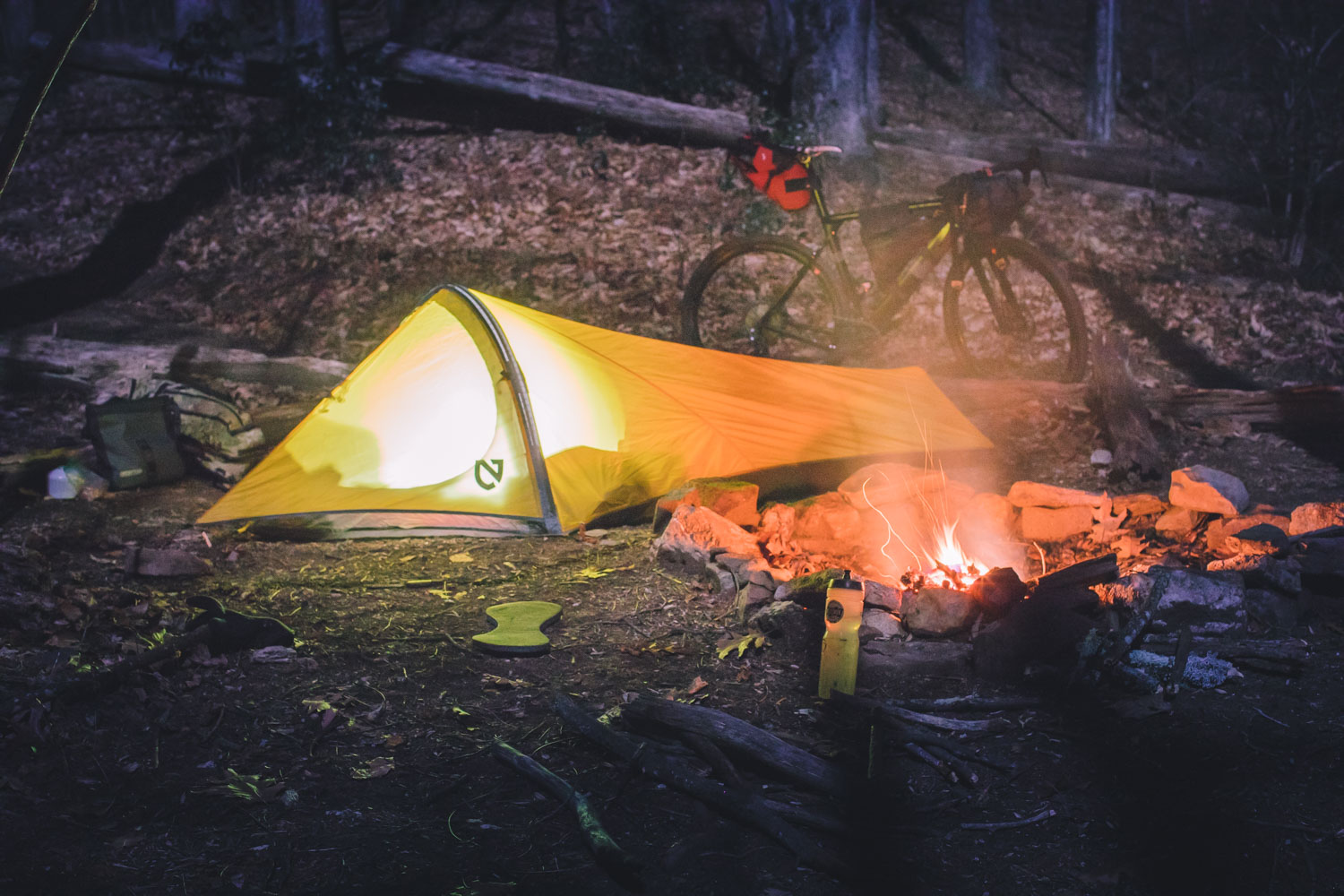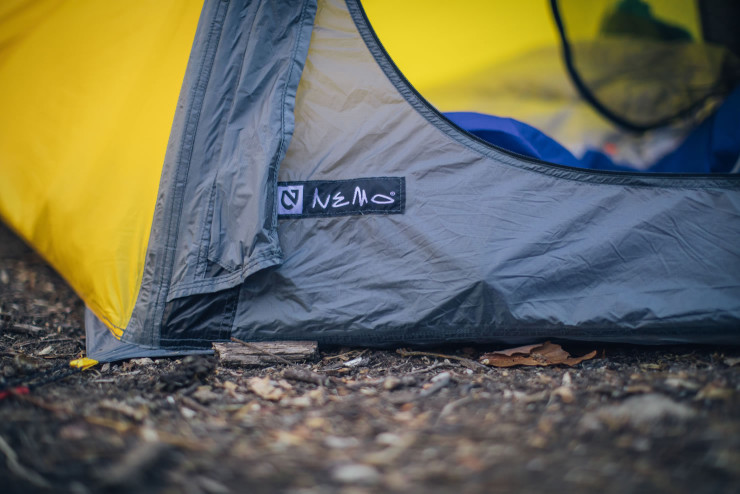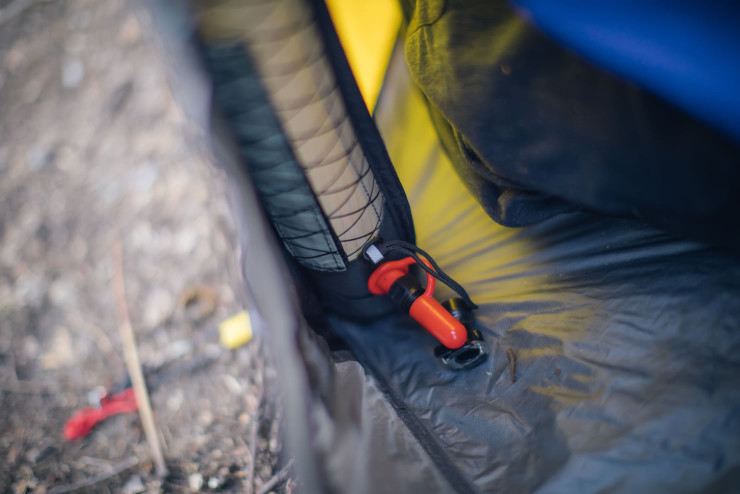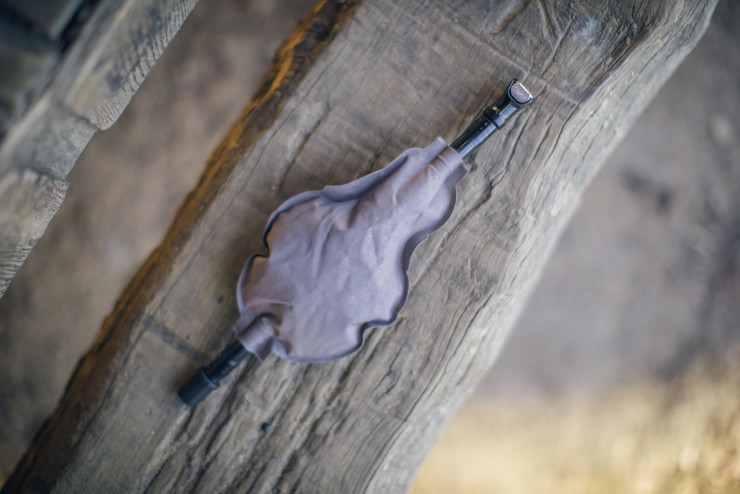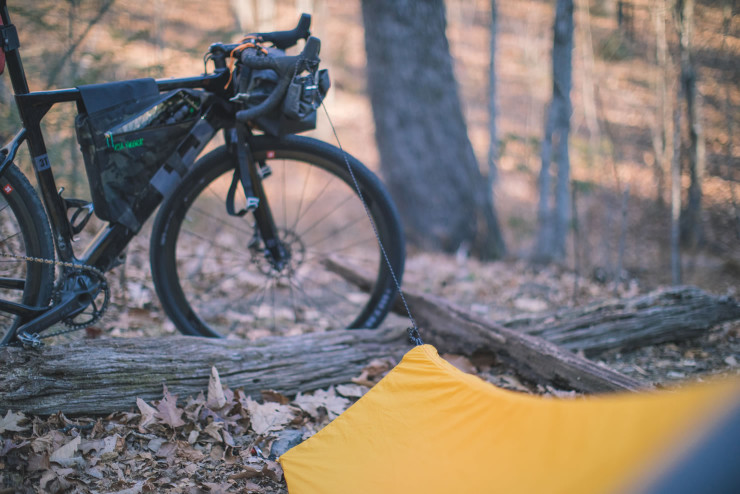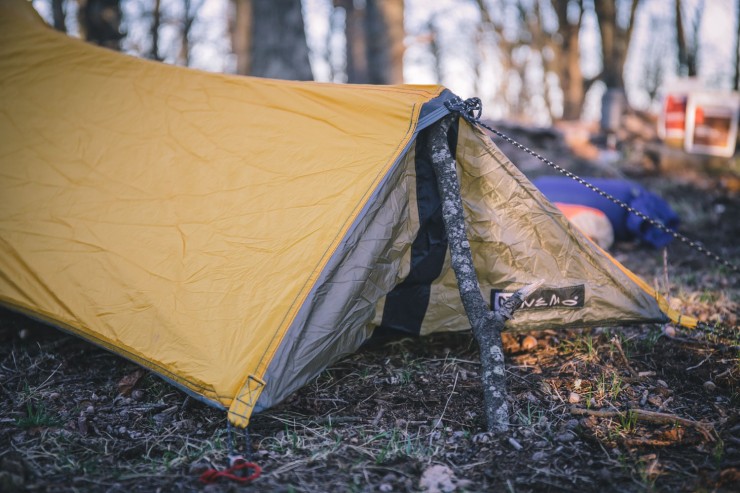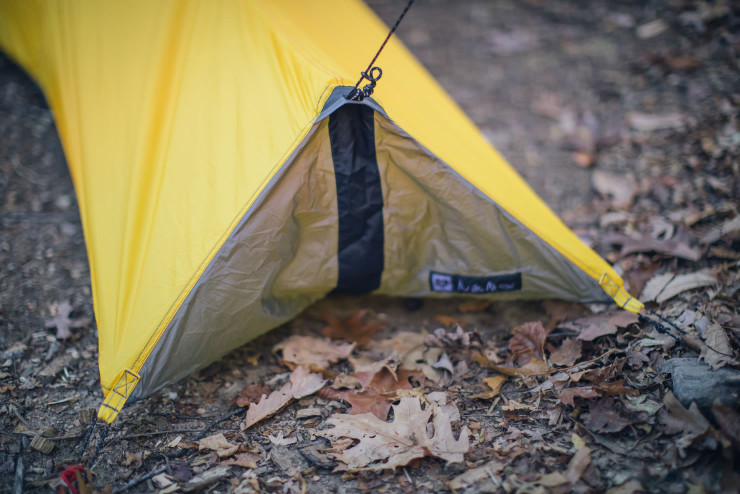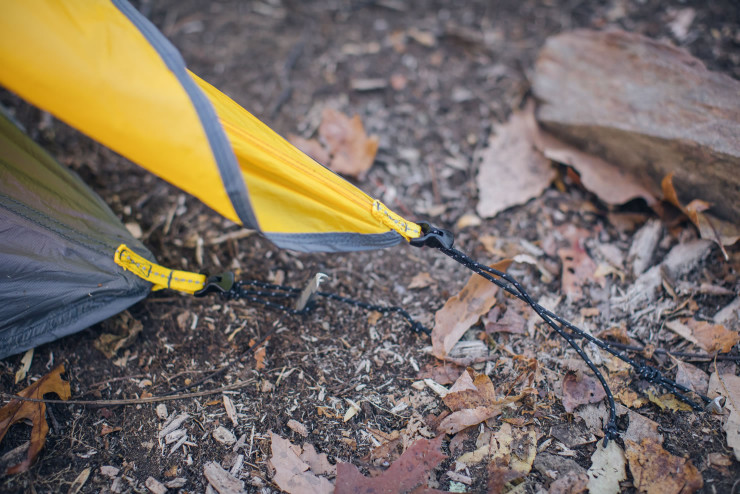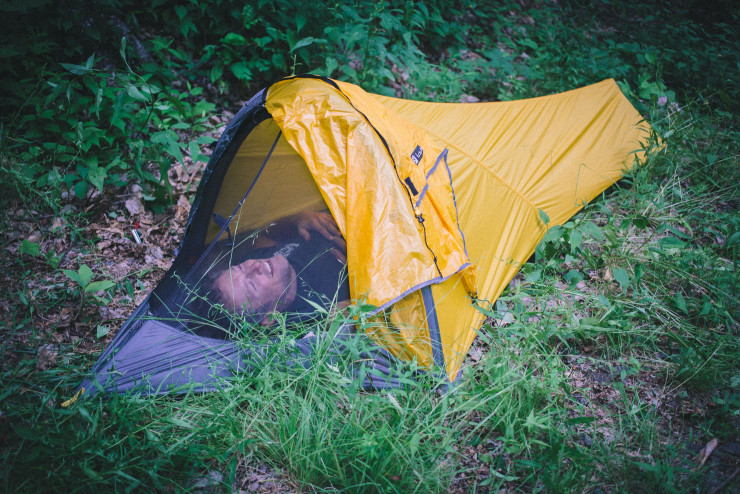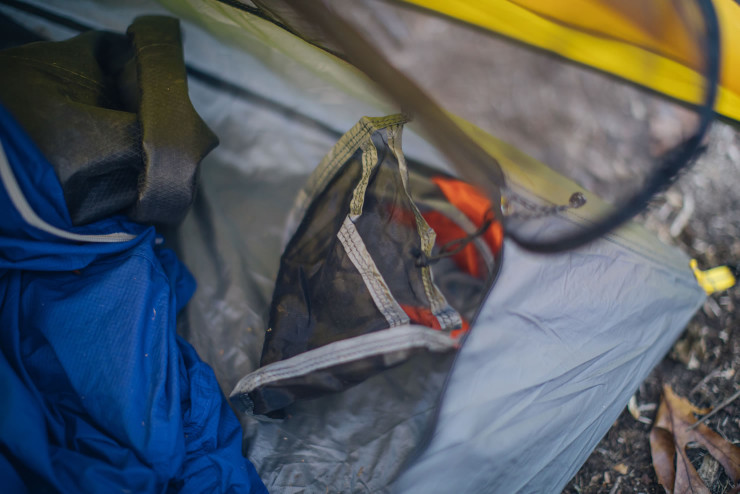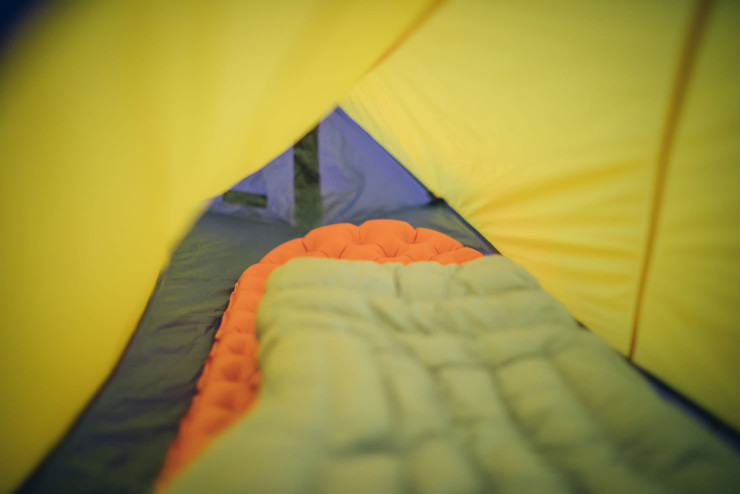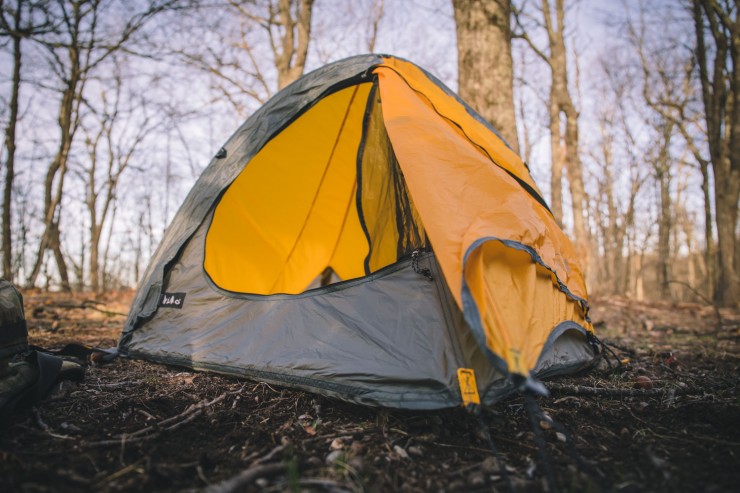Nemo Gogo Elite Shelter Review: Demons at bay.
If you are looking for a shelter to minimize packing space — and seal out things that crawl, bite, or just plain scare the hell out of you — the Nemo Gogo Elite might just be the best non-bivy option on the market. But then again, maybe not if you’re afraid of small spaces…

Allow me to me preface by saying that I’m not a bivy sack kind of a guy. And I’m not a tarp person either. I like my shelters to be dry, not touching me, and hermetically sealed from things that slither and crawl. Don’t get me wrong, I’m not averse to suffering, I just prefer a nice and comfortable sleep after a long ride. Unfortunately, this clashes with my ongoing quest to pack less and save space. On most overnighters and weekend trips I try and keep luggage to a minimum and maintain as much of the bike’s intended feel and ride as possible, especially on a full suspension rig. That means carrying very little and finding gear that’s simple and small. Those features are what attracted me to the Nemo Gogo Elite. Its packed size — comparable to that of a large head of cabbage — is smaller than the majority of one-person tents on the market.

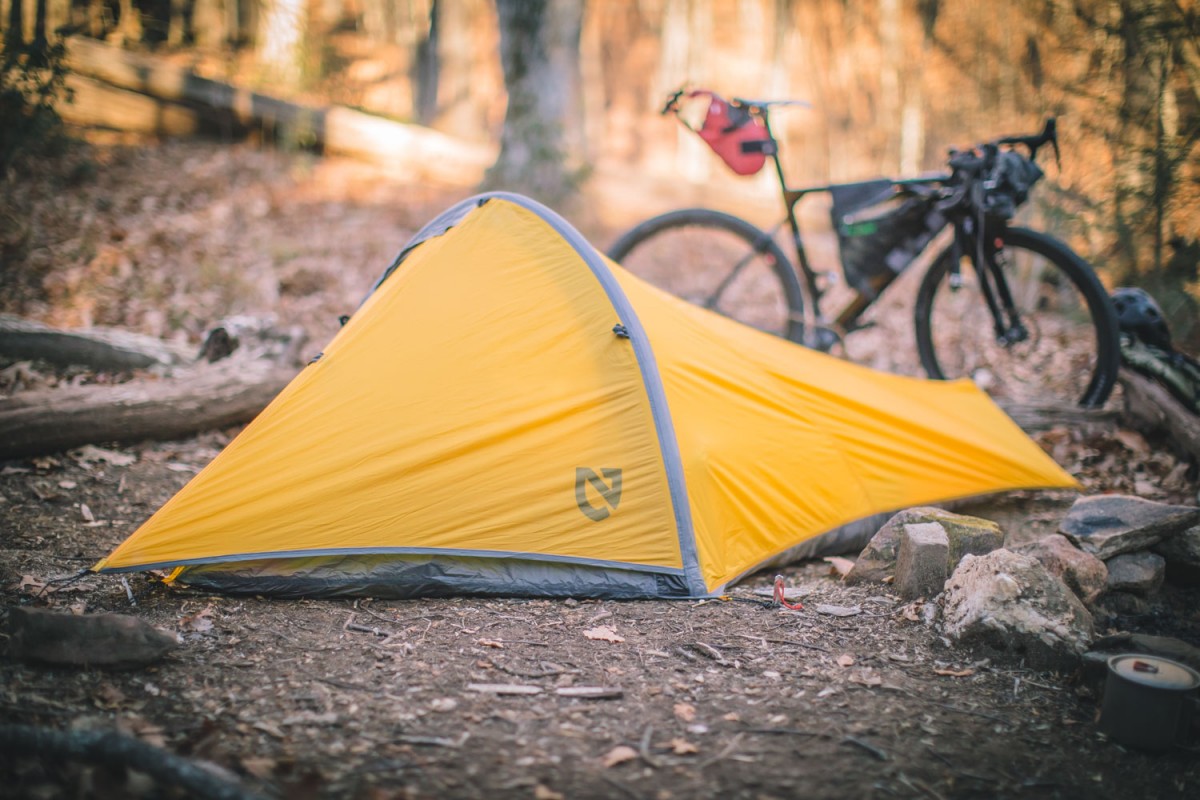
The Gogo Elite’s compact dimensions are owed to the fact that it doesn’t require poles to set it up. To keep its shape, the Gogo Elite makes use of an air-filled arc and six stakes. Once pitched it resembles a very small tent, although it’s kind of a bivy too. I was a little leery of an inflatable structural support before I used it. I expected a flimsy tube made out of material similar to that of a sleeping pad. To my surprise, the ~2.5″ diameter arch is made from a reinforced and almost plasticized fabric that holds air at fairly high pressure. Nemo’s ‘Air Supported Technology’ works via a small squeeze pump which affixes to the beam’s plastic valve at the base of the tent. Nemo doesn’t specify the PSI of the arch, but it gets surprisingly rigid. The plastic and metal clip valve is a little tricky, and perhaps a bit overbuilt, but after a few uses the Gogo Elite sets up really quickly, leading me to believe that it would be a good option for long distance races as well.
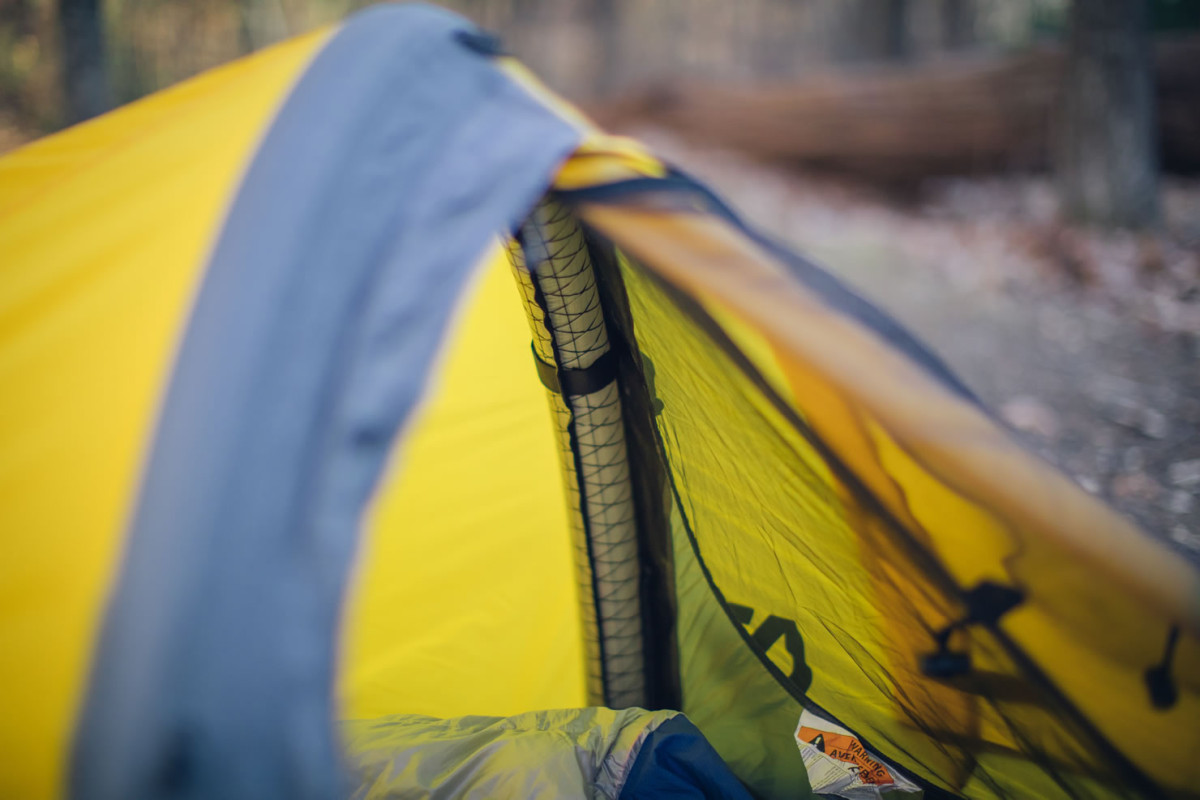
In addition to the built in air beam, the Gogo Elite relies on six stakes to give it its shape. One for each corner and two for the endpoints. The foot of the Gogo, or “the swallowtail” as Nemo describes it, sets up with any 16-18″ stick. The stick is held in its vertical position with a tension cord that connects to the rear peak. The swallowtail can also be held up by tying it off to a tree branch…. or a bike. As shown in these photos, I tried setting it up using both methods; it works well either way. I will say that, for the price, Nemo should have included better stakes. Two of them bent the first time I pitched the shelter. Other than that, the Nemo Gogo Elite is well constructed, sets up taught, and seems like it will stand up well in rough and gusty conditions. For folks planning on camping in really windy conditions, I have read that the Elite can be modified by adding two grommets on the floor’s sides to stake it wider for even more stability.
The Nemo Gogo Elite’s shell is constructed from a 10 denier “OSMO Elite” waterproof/breathable shell and the beak shell from 10 denier polyurethane-coated ripstop nylon. Considering that this is a single-walled shelter, it seems about right for the weight to strength ratio. I’ve used it in temps down to 7°F, which is far colder than I’d like to be out sleeping on the forest floor. It is hard to discern whether the single wall shell ups the r-value, but it’s safe to say that this is a 3-season tent. The 20D nylon floor is rather thin and I’ve noticed that it does get a little damp when used without a ground sheet. NOTE: The version I tested is the 2016 version and since publication, a new version has launched with 10D PeU Nylon Ripstop shell and 15D PeU floor fabric.
Because the Gogo Elite’s interior space is so compact, I expected it to be a den of condensation. While I’ve read some forums where users have complained of the issue, it hasn’t been too much of a problem for me. Granted, I’ve only used the tent during fall, winter, and early spring, so maybe it gets worse during the summer months. The front ‘beak’ of the shelter has a mesh inner which is nice for stargazing on clear nights. It also helps to eliminate any stuffy or crowded feeling while warding off potential condensation. I have heard of people cutting a small window in the foot area and adding a mesh pane with Velcro to hold the flap open or closed, thus creating a cross breeze for added ventilation. This step seems like overkill to me, but I can see the potential benefit.
The Gogo Elite tent-bivy is incredibly long. I am 6’0″ (183cm), and I can comfortably stretch out and still have plenty of room to stow clothing, camera gear, and other such items in the head/’beak’ area. There’s also a mesh pocket for stowing smaller bits and bobs (aka electronics). One thing that has been slightly difficult for me to get accustomed to is not having a vestibule to protect shoes and other items from overnight rainfall and heavy dew events. Considering the size and weight savings this bivy provides, a small cuben fiber bag might be a good solution to my vestibule hang-up. One suggestion: if you’re aren’t super tall, and looking for a vestibule to store your shoes and other gear, you could unclip the mesh vestibule and roll it back, while keeping the Nylon vestibule staked out. Since Gogo is so long, you can sleep in the back part of the tent and still have a separate vestibule.
Sleeping inside the Gogo Elite is not the claustrophobia inducing experience I feared it would be. Unlike most bivys I’ve seen, the air-filled arch keeps the ceiling far above its inhabitant’s head and shoulders. There isn’t enough room to sit, but it’s far from being too coffin-esqe. In traditional bivy form, the Gogo is quite narrow. There isn’t much wiggle room, so restless sleepers beware. It’s also a bit tricky to change clothes inside the tent. I typically do all of my preparations outside and only crawl in when it’s time for shut-eye. That’s what being in the outdoors is all about anyway, right?
The Gogo Elite isn’t new; it’s actually been around for a few years now. In 2011/2012, Nemo was just coming into the mainstream outdoor gear industry with tents that seemed fairly innovative. With the “low-pressure airbeam” used to eliminate poles, the Gogo Elite shelter was definitely a part of this. It stands to reason that it has seen revisions and will see more. When asked if there are any more changes coming to the Gogo Elite, Nemo responded that they just changed to a slightly different shell and beak fabric (10D PeU Nylon Ripstop) and the floor fabric to a 15D PeU. This reduces the overall weight by about 2.5oz. When putting the one I tested toe to toe with several one-person tents such as the Big Agnes Fly Creek HV UL1 at 2lb 1oz (936g), Nemo’s own 1p Hornet Elite tent at 1lb 14oz (850g), or the Big Agnes Fly Creek HV1 Platinum at 1lb 13oz (822g), the Gogo Elite seems somewhat heavy for such a small shelter at 1lb 10oz (753g) [as tested, 2016 version]. However, with the 2017 fabric upgrades, that should drop it an additional 75 grams. And when comparing them just for packing space, you’ll be hard-pressed to find something more minimal than the Gogo Elite without resorting to a bivy or a tarp. As for price, the Gogo Elite isn’t cheap either. It retails for $449 while the aforementioned BA UL1 sells for $349, the Hornet for $449, and the HV1 for $499.
Pros
- Packs extremely small given that it’s a fully enclosed shelter.
- Lightweight. While it’s not the lightest on the market, it still very ultra lightweight for a fully sealed shelter.
- Door/net design allows for star-gazing and prevents condensation when it’s not raining.
- The inflatable arc structure is quick to set up, offers a fairly sturdy structure, and eliminates the need for poles.
- Minimal mesh body is good for added insulation in colder weather.
Cons
- Stakes are some of the worst I’ve seen; they bent on day one. For the price point, Nemo should include better stakes.
- Small interior. There’s no sitting up in this shelter. Although, it’s worth noting that I found adequate room for camera gear, clothes bag, and a few other items inside aroung the hear and shoulders area.
- Condensation has been reported nay several other users with such a small space when it’s raining/humid; although this hasn’t been an issue during my testing period (mostly fall/winter/early spring).
- No vestibule. There is no covered storage space outside the shelter area; as mentioned, there can be for shorter folks.
- Not too much lighter than high-end 1p tents on the market (namely the Demo Hornet Elite 1p and Big Agnes Fly Creek HV1).

- Weight (as tested/2016 version): 26.5oz (753g); see above
- Price: $449
- Who’s it for: Tour Divide racers, Full-sus Bikepackers
- Place of manufacture: China
- Contact: NemoEquipment.com
Wrap Up
Before trying it, I didn’t get my hopes too high for the Nemo Gogo Elite. I’m not a big fan of bivvies, so I anticipated a flimsy, cramped, and muggy space. Instead, I found it to be very sturdily built and surprisingly spacious, although still a bit confining. In conclusion, it’s a durable piece of equipment that’s several steps above a bivy sack. It sets up quickly, and it’s nice and long, with enough room for some gear in the beak area. The mesh window to the stars is another great feature. Of course, if you have any fear of small spaces, the Nemo Gogo Elite might not be for you. The price is also a bit scary when compared to other one-person tents that don’t weigh that much more. But if packing space is top-priority, and the thought of having beetles and spiders walk on your face brings you shivers, the Nemo Gogo Elite is well worth considering.
Please keep the conversation civil, constructive, and inclusive, or your comment will be removed.






